
 i_need_contribute
i_need_contribute
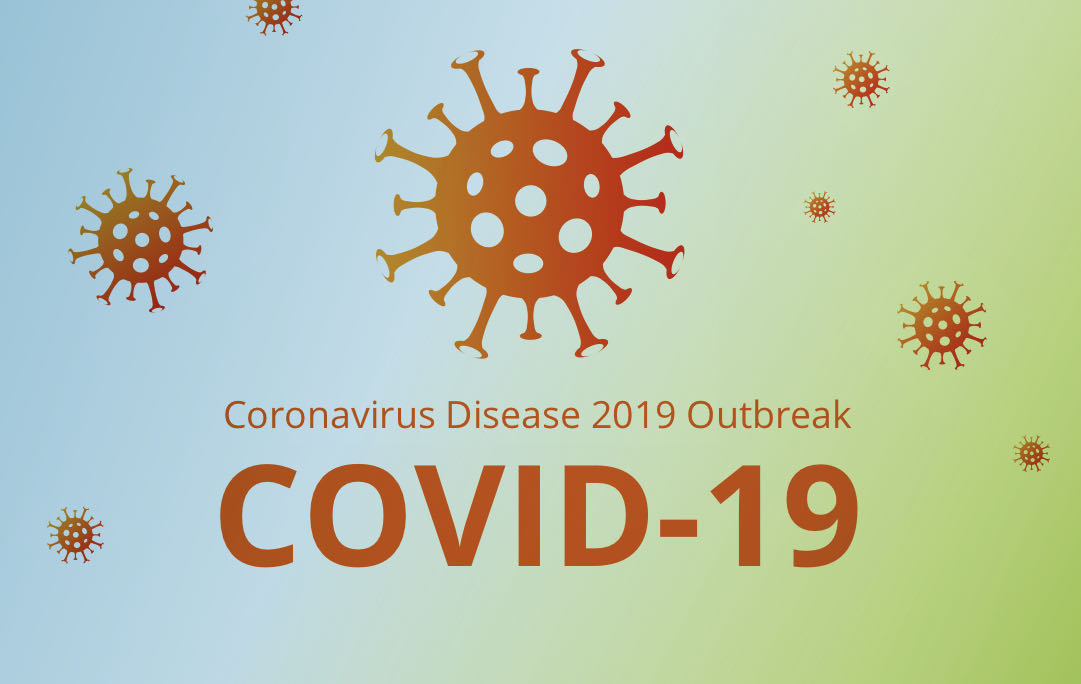
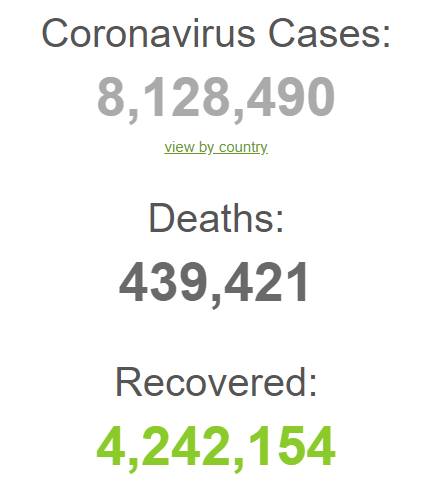
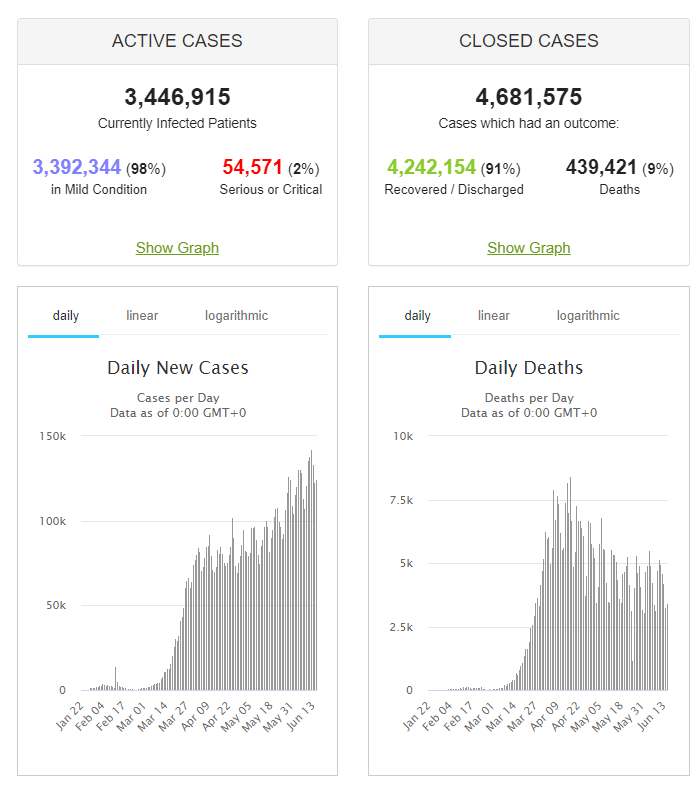
|
# |
Country, |
Total |
New |
Total |
|
|
World |
8,108,667 |
+124,600 |
438,596 |
|
1 |
2,182,950 |
+20,722 |
118,283 |
|
|
2 |
891,556 |
+23,674 |
44,118 |
|
|
3 |
537,210 |
+8,246 |
7,091 |
|
|
4 |
343,026 |
+10,243 |
9,915 |
|
|
5 |
296,857 |
+968 |
41,736 |
|
|
6 |
291,189 |
+181 |
27,136 |
|
|
7 |
237,290 |
+301 |
34,371 |
|
|
8 |
232,992 |
+3,256 |
6,860 |
|
|
9 |
189,876 |
+2,449 |
8,950 |
|
|
10 |
188,044 |
+373 |
8,885 |
|
|
11 |
179,831 |
+1,592 |
4,825 |
|
|
12 |
179,436 |
+5,143 |
3,362 |
|
|
13 |
157,372 |
+152 |
29,436 |
|
|
14 |
146,837 |
+4,147 |
17,141 |
|
|
15 |
144,478 |
+5,248 |
2,729 |
|
|
16 |
132,048 |
+4,507 |
1,011 |
|
|
17 |
99,147 |
+360 |
8,175 |
|
|
18 |
90,619 |
+3,099 |
1,209 |
|
|
19 |
83,181 |
+49 |
4,634 |
|
|
20 |
80,876 |
+1,274 |
76 |
|
|
21 |
73,533 |
+3,495 |
1,568 |
|
|
22 |
60,100 |
+71 |
9,661 |
|
|
23 |
54,680 |
+707 |
312 |
|
|
24 |
53,063 |
+2,124 |
1,726 |
|
|
25 |
52,383 |
+139 |
4,891 |
|
|
26 |
48,948 |
+165 |
6,065 |
|
|
27 |
47,322 |
+571 |
3,929 |
|
|
28 |
46,289 |
+1,691 |
1,672 |
|
|
29 |
42,636 |
+342 |
291 |
|
|
30 |
40,818 |
+214 |
26 |
|
|
31 |
39,294 |
+1,017 |
2,198 |
|
|
32 |
37,036 |
+346 |
1,520 |
|
|
33 |
36,431 |
+511 |
298 |
|
|
34 |
32,785 |
+1,208 |
854 |
|
|
35 |
31,810 |
+656 |
901 |
|
|
36 |
31,131 |
+14 |
1,939 |
|
|
37 |
29,788 |
+396 |
1,256 |
|
|
38 |
26,420 |
+490 |
1,098 |
|
|
39 |
25,527 |
+761 |
478 |
|
|
40 |
25,321 |
+18 |
1,706 |
|
|
41 |
24,524 |
+1,043 |
108 |
|
|
42 |
23,271 |
+309 |
605 |
|
|
43 |
22,165 |
+166 |
1,427 |
|
|
44 |
21,422 |
+736 |
448 |
|
|
45 |
21,315 |
+1,106 |
652 |
|
|
46 |
19,237 |
+182 |
302 |
|
|
47 |
19,013 |
+786 |
46 |
|
|
48 |
18,459 |
+617 |
611 |
|
|
49 |
17,502 |
+73 |
925 |
|
|
50 |
17,135 |
+26 |
678 |
|
|
51 |
17,064 |
+397 |
285 |
|
|
52 |
16,658 |
+573 |
424 |
|
|
53 |
14,809 |
+313 |
81 |
|
|
54 |
12,367 |
+57 |
255 |
|
|
55 |
12,217 |
+24 |
598 |
|
|
56 |
12,121 |
+36 |
277 |
|
|
57 |
11,964 |
|
54 |
|
|
58 |
11,879 |
+139 |
411 |
|
|
59 |
11,031 |
+112 |
777 |
|
|
60 |
10,324 |
+367 |
122 |
Source: https://www.worldometers.info/coronavirus/
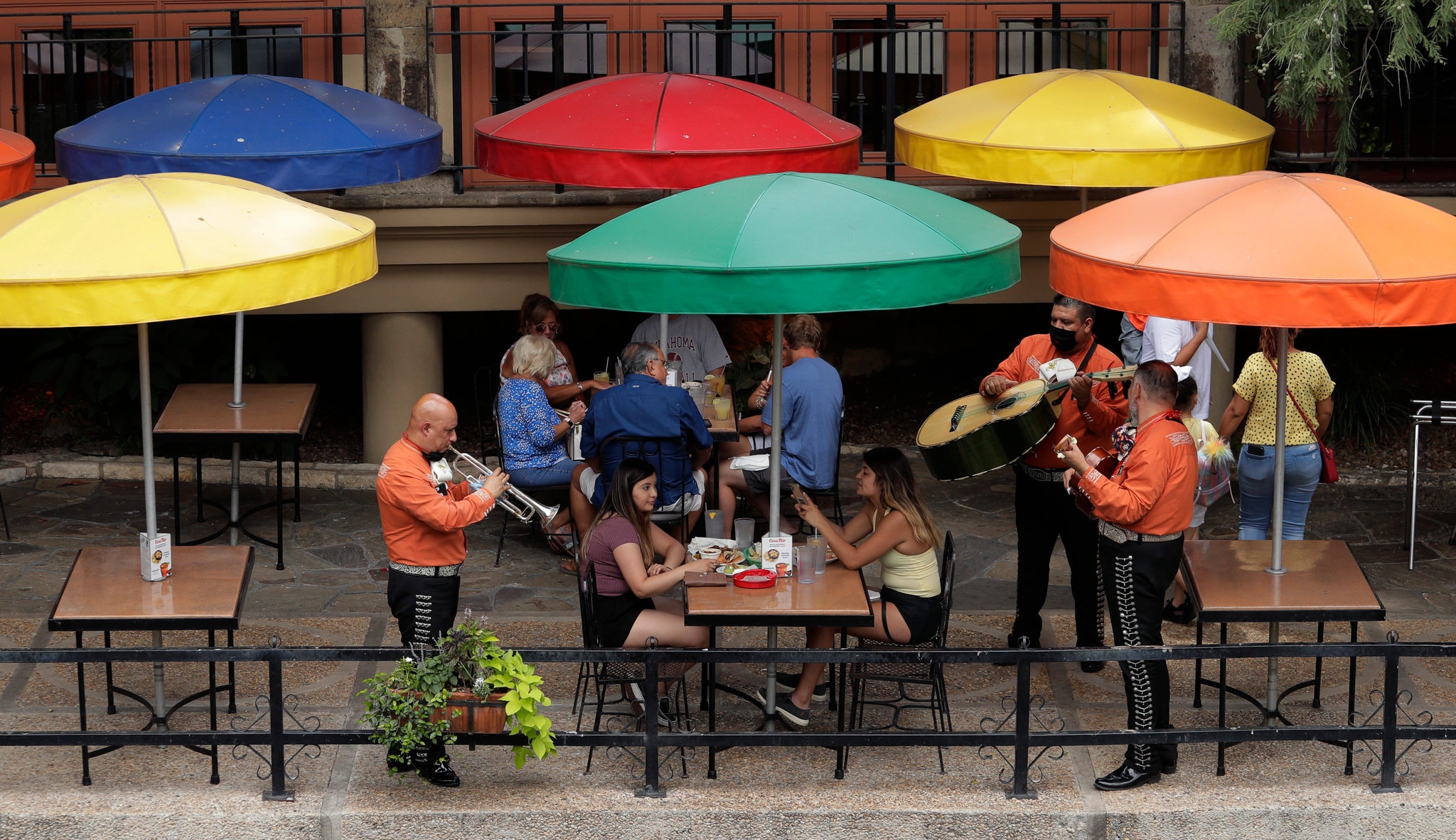
A mariachi group plays for diners at a restaurant along the River Walk that has reopened in San Antonio on Monday. The restaurant had been closed because of the pandemic.Credit...Eric Gay/Associated Press
Bars and restaurants that only recently reopened around the country are being forced to close their doors again, or at least suspend dining in, amid new infections.
In some cases, the closings came after employees tested positive. In others, it was the patrons who were found to be infected.
In Phoenix, where cases have been on the rise, the Porch Arcadia, which reopened May 11, announced that it was temporarily closing again so it could test all of its workers and do a “thorough deep cleaning and sanitizing of the entire building.” It said someone who had been in the restaurant had tested positive. Another restaurant, Chelsea’s Kitchen, said on Facebook that it had suspended dine-in service and moved back to curbside takeout and delivery after “a person close to the restaurant” tested positive.
In Texas, some San Antonio bars decided to shut down, among them Hills & Dales Icehouse, which cited “the recent surge of positive Covid-19 cases.” It said it would remain closed until it felt safe for workers and patrons to return.
A number of Florida bars — including in Naples, St. Petersburg and the Orlando suburbs — told customers that they were voluntarily shutting down their dining rooms because employees had tested positive. St. Petersburg’s mayor, Rick Kriseman, urged other businesses to also close if any of their workers get sick.
On Saturday, Florida reported its highest single-day number of cases since the outbreak began: 2,581.

Getting a swab test in Beijing on Tuesday.Credit...Noel Celis/Agence France-Presse — Getty Images
For months, Beijing residents learned to look warily on any visitors who might bring the coronavirus into the city and spread infections. Now, they are potential targets of monitoring, quarantine and suspicion across China after a burst of more than 100 infections in the national capital since last week.
Dozens of cities and provinces across China have in recent days stepped up monitoring and quarantine measures for people from Beijing after the government confirmed a flare-up of new cases that was traced to the Xinfadi wholesale food market in the city’s south. At least one city — Daqing, an oil-producing city in the northeast — more or less signaled that all people from Beijing should stay away.
“In view of the rapidly escalating epidemic control developments in Beijing, from today individuals coming from Beijing to Daqing must undergo 21 days of isolation,” the city authorities announced on Monday, according to The Beijing News. The Daqing health authorities also “recommended that residents do not venture to Beijing for now unless it is essential.”
Harbin, another city in northeast China, ordered that allarrivals from Beijing had to go into “centralized quarantine” — which usually means confinement to an assigned hotel or dormitory room — while they undergo two nucleic acid tests to check if they have the virus.
Beijing has reinstated some wider controls in an effort to stifle the spread of the virus. The city postponed a scheduled return to classrooms by some elementary students. Taxis and ride services have been ordered not to leave the city. Restaurants have banned banquets. The lockdown of residents — preventing them from leaving their housing compounds or receiving visitors — expanded on Tuesday to seven neighborhoods in the west of Beijing, where an infected person had visited a market.
Even so, the quarantine steps and general anxiety about the outbreak in Beijing have underscored how even limited outbursts of new infections could frustrate efforts to return to normal in China and other countries.
Xi Jinping, China’s top leader, has made defending Beijing from mass infections a priority. City officials are under particular pressure to extinguish the new outbreak quickly.
“Make containing the outbreak the most important and urgent task for now,” Cai Qi, the Communist Party secretary of Beijing, and a protégé of Mr. Xi, said at a meeting of officials on Monday. “Adopt the most resolute, decisive and strictest measures.”
More than half of all four-year colleges and universities in the U.S. will not require applicants to submit SAT or ACT scores for admissions this fall, an anti-testing group said Monday, a major shift in the way colleges select students that has been accelerated by the pandemic.
The group, FairTest, said that 1,240 of the 2,330 institutions that granted bachelor’s degrees in the 2018-19 academic year have now made the tests optional. The total includes nearly 200 colleges and universities that have at least temporarily dropped the testing requirement since the spring, when the outbreak forced the cancellation of many test dates.
The tests have long been criticized as being unfair to low-income, black and Hispanic students, leading a growing number of colleges to make testing optional. Supporters say they provide a uniform way of judging students across schools.
Some of the most selective schools in the country have announced that they are making the SAT and the ACT optional for at least the coming application cycle, including Brown University, Carnegie Mellon, Columbia and Cornell, according to FairTest.
Bob Schaeffer, the president of FairTest, said that if the past was any guide, some schools would not restore the testing requirement when the pandemic was over.
And on Monday night, Harvard said that because of disruptions caused by the pandemic, it will not require applicants to submit SAT or ACT scores for the next admissions cycle, putting the imprimatur of perhaps the country’s most prestigious university on the building move away from the use of standardized tests in admissions.
“We understand that the COVID-19 pandemic has created insurmountable challenges in scheduling tests for all students, particularly those from modest economic backgrounds, and we believe this temporary change addresses these challenges,” Harvard said in the announcement, posted on its website.
“Students who do not submit standardized testing this coming year will not be disadvantaged in the application process. Their applications will be considered on the basis of what they have presented, and they are encouraged to send whatever materials they believe would convey their accomplishments in secondary school and their promise for the future.”
With the addition of Harvard, 1,241 of the 2,330 institutions that granted bachelor’s degrees during the 2018-19 academic year have now made the tests optional, according to FairTest, an anti-testing organization that is keeping track of the movement. That number includes nearly 200 colleges and universities that — like Harvard — have at least temporarily dropped the testing requirement since the virus began spreading in the spring. Many spring test dates were canceled because of the pandemic, making it difficult for students to take the test and submit their scores.
Harvard has long said that standardized tests are only a small part of what the admissions office considers. The announcement said that students also will not be penalized for having pass/fail grades or limited extracurricular activities because of the virus. The tests will be optional for those applying to Harvard’s Class of 2025; regular applicants must submit by Jan. 21, 2021.
But some test experts are suggesting that if the change works out, universities may choose to continue the practice once the pandemic has receded.

A woman holds a sign listing “Covid Cures” including hydroxychloroquine, at a protest against restrictions implemented in response to the coronavirus disease (COVID-19) outbreak in Massachusetts last month.Credit...Brian Snyder/Reuters
The Food and Drug Administration said Monday that it was revoking emergency authorization of two malaria drugs to treat Covid-19, saying that they are “unlikely to be effective.”
The drugs, hydroxychloroquine and a related drug, chloroquine, were heavily promoted by President Trump after a handful of small, poorly controlled studies showed that they could work in treating the disease.
Mr. Trump even took hydroxychloroquine after he was exposed to two people who had tested positive for the coronavirus. The agency said that after reviewing some data, it had determined that the drugs, particularly hydroxychloroquine, did not demonstrate benefits that outweighed their risks. Earlier this year, the F.D.A. issued a warning that the drugs could cause alarming heart arrhythmias.
In March, the F.D.A. authorized stockpiles of the drugs to be used in hospitals to treat patients with the virus. But in a letter Monday revoking the authorization, the agency said that further studies have shown that the two drugs were unlikely to be effective in stopping the virus, and that current national treatment guidelines don’t recommend using them outside of clinical trials.
According to the letter, written by Denise M. Hinton, the F.D.A.’s chief scientist, the request to revoke the authorization came from the Biomedical Advanced Research and Development Authority, a unit of the Department of Health and Human Services that is in charge of supplying treatments in public health emergencies.
Members of Congress have questioned increases in the F.D.A.’s granting of emergency use authorizations during the pandemic for certain drugs as potential treatments. They have also questioned authorizations for antibody and diagnostic tests whose data had not been thoroughly vetted before approval, and for certain types of masks and other devices. Some Democratic lawmakers have criticized the Trump administration for pressuring the agency into issuing too many emergency approvals.

A Tanzanian truck driver reacts as he is tested for the coronavirus on the Kenya side of the Namanga border crossing with Tanzania this month.Credit...Brian Inganga/Associated Press
For months, many African nations managed to stave off, or at least slow, the spread of the coronavirus, partly by closing borders early and banning public gatherings.
The virus is now racing across Africa, aided by public health measures that are being applied haphazardly — or not at all.
At a Central African Republic border town this week, dozens of truck drivers dutifully pulled over by a tent to be tested for the virus before they could proceed.
In the meantime, ordinary people drifted back and forth across the border, often unchecked.
When the authorities did pull over a bus for a spot check as it neared the capital, one passenger who admitted to feeling “malarial” was pulled off. He tested positive for the virus and was sent to a hospital, but the conditions were so bad there that he ran away, he said later.
“They are still looking for me,” he said, “and I think that they would like to punish me. But they will never get me.”
Last week the World Health Organization said Africa’s confirmed cases had doubled in 18 days to reach 200,000.
“Africa needs to intensify its efforts to slow the spread of the pandemic,” experts from the Africa Centers for Disease Control and Prevention said in an article published in the journal Nature.
But with what the authors said was a “catastrophic shortage” of health professionals and medical supplies, that will not be easy. Even basic safety measures are sometimes being ignored.

Raul Lisboa, 89, waves to his daughters through a transparent plastic curtain at a senior nursing home in Sao Paulo, Brazil, on Saturday.Credit...Nelson Almeida/Agence France-Presse — Getty Images
In just six months, nearly 8 million people worldwide have been stricken with confirmed cases of Covid-19, and at least 434,000 have died. But those deaths have not been distributed evenly; among the most vulnerable are people with underlying health conditions, such as diabetes and diseases that affect the heart and lungs. According to a new modeling study, roughly 1.7 billion people around the world — 22 percent of the global population — fall into that category.
That estimate, published today in The Lancet Global Health, excluded healthy older individuals without underlying health conditions, a group also known to be at risk because of their age. It also did not take into account risk factors like poverty and obesity, which can influence a person’s susceptibility to disease and access to treatment.
But such data could help health officials focus containment efforts on people vulnerable to the virus’s most dangerous effects and, perhaps, eventually prioritize them for vaccination, said Andrew Clark of the London School of Hygiene and Tropical Medicine, the study’s first author. Since the early days of the pandemic, researchers have known that chronic conditions can exacerbate disease. Now, there’s a better “understanding of the numbers involved,” Dr. Clark said.
The study also estimated that about 4 percent of the world’s population, around 349 million people, would require hospitalization if they became infected. That number includes patients without underlying medical conditions, such as healthy, older adults; and the risk of hospitalization increases with age.
House Democrats announced on Monday that they were launching an investigation into how the Trump administration has allocated roughly $660 billion in small business loans as part of the stimulus law enacted to cushion the economic blow of the pandemic.
The seven Democrats on a special oversight committee created to scrutinize how the administration is spending pandemic relief money sent letters to the Treasury Department and the Small Business Administration — the two agencies that administer the Paycheck Protection Program — as well as eight large banks, asking for documents and information about how funds were distributed and which businesses received them.
“The administration should release the names of all PPP borrowers — as the S.B.A. routinely does for similar loan programs,” the lawmakers wrote in the letters which went to banks including JP Morgan Chase, Bank of America, Wells Fargo and Citibank. “Contrary to Secretary Mnuchin’s recent testimony, there is nothing ‘proprietary’ or ‘confidential’ about a business receiving millions of dollars appropriated by Congress, and taxpayers deserve to know how their money is being spent.”
Their action came days after Treasury Secretary Steven Mnuchin told a Senate committee that information about who was receiving the loan money was “proprietary” and not subject to public release.
Facing a backlash for the remarks, Mr. Mnuchin said on Monday that he would look for a way to allow for more oversight of where the government-backed loan money was going. The lack of transparency threatened to derail future economic relief efforts and was quickly becoming a political problem for the White House, as Democrats and Republicans sought additional information about the loans.
“I will be having discussions with the Senate Small Business Committee and others on a bipartisan basis to strike the appropriate balance for proper oversight of PPP loans and appropriate protection of small business information,” Mr. Mnuchin said on Twitter on Monday.
Not long after, House Democrats announced their inquiry. They said they were concerned that a “two-tiered system” for processing applications “may have diverted PPP funds intended for vulnerable small business owners in underserved and rural markets.”

Pedestrians in Myrtle Beach, South Carolina last month. The state has seen the number of coronavirus cases rise steeply in recent days.Credit...Sean Rayford/Getty Images
As the number of virus cases in South Carolina has risen steeply in recent days, Representative Tom Rice, a Republican, announced Monday that he had contracted the virus, becoming the latest member of Congress known to become infected.
South Carolina — whose governor was among the last to issue a stay-at-home order when the virus first struck and was also among the first to begin opening up his state — has seen a sharp rise in cases in recent days. The state allowed some retail stores to begin reopening with social distancing back on April 20, and has continued to allow more businesses to reopen, with Gov. Henry McMaster giving the green light Friday to bowling alleys.
The state recorded its highest number of new cases yet in one day on Sunday, according to a New York Times database: 840. The tally made South Carolina the state with the seventh-highest number of new cases in the country that day, with more new cases reported there than in New York. And while some states make incomplete reports on weekends, the trajectory in South Carolina has been going up for days.
The state is now logging almost six times as many cases each day as it did when it began reopening. The week leading up to April 20, when it began reopening, it was averaging 142 new cases a day. All told there have been at least 18,795 cases of the virus in South Carolina, according to the database, and as of Monday morning at least 600 people had died.
In his statement on allowing bowling alleys to reopen, Mr. McMaster said Friday: “Businesses simply can’t be closed indefinitely, but they can operate in a safe way with our collective knowledge of the virus.”
Mr. Rice announced on Facebook that he and his wife and one of their sons had contracted the virus and that they were all improving, including his son, who had the most severe case.
“I was lucky, and it was not bad for me,” Mr. Rice wrote. “I had a low fever and a mild cough. It was gone by Thursday. I never stopped eating or drinking or working or moving. The only bad thing is I have completely lost sense of taste and smell. CAN’T TASTE BACON!!!”

Rescue workers move a coffin to transport the body of a victim of Coronavirus at a hospital in Hyderabad, Pakistan last week.Credit...Nadeem Khawer/EPA, via Shutterstock
Pakistanis stricken by the virus are being turned away from hospitals that have simply closed their gates and put up signs reading “full house.” Doctors and nurses are falling ill at alarming rates — and are also coming under physical assault from desperate and angry families.
When Pakistan’s government lifted its lockdown on May 9, it warned that the already impoverished country could no longer withstand the shutdown needed to mitigate the pandemic’s spread. But now left unshackled, the virus is meting out devastation in other ways, and panic is rising.
Before reopening, Pakistan had recorded about 25,000 infections. A month later, the country recorded an additional 100,000 cases — almost certainly an undercount. At least 2,729 people have died, according to a Times database.
Pakistan is now reporting so many new cases that it is among the W.H.O.’s top 10 countries where the virus is on the rise. The W.H.O. wrote a letter criticizing the government’s efforts on June 7 and recommended that a lockdown be reimposed, stating that Pakistan did not meet any of the criteria needed to lift it.
Compounding the dire situation, medical workers across Pakistan are being assaulted on a near-daily basis for not being able to admit patients or having to tell families that their loved ones had died.
“Our hospitals are completely exhausted,” said one doctor, who asked for his name to be withheld because he is a government employee.
Medical professionals now expect the virus to peak in July or August and infect up to 900,000, adding further strain to an already shaky health care system that some warn may collapse.
But government officials have ruled out the possibility of a further lockdown and dismissed the W.H.O. recommendations.
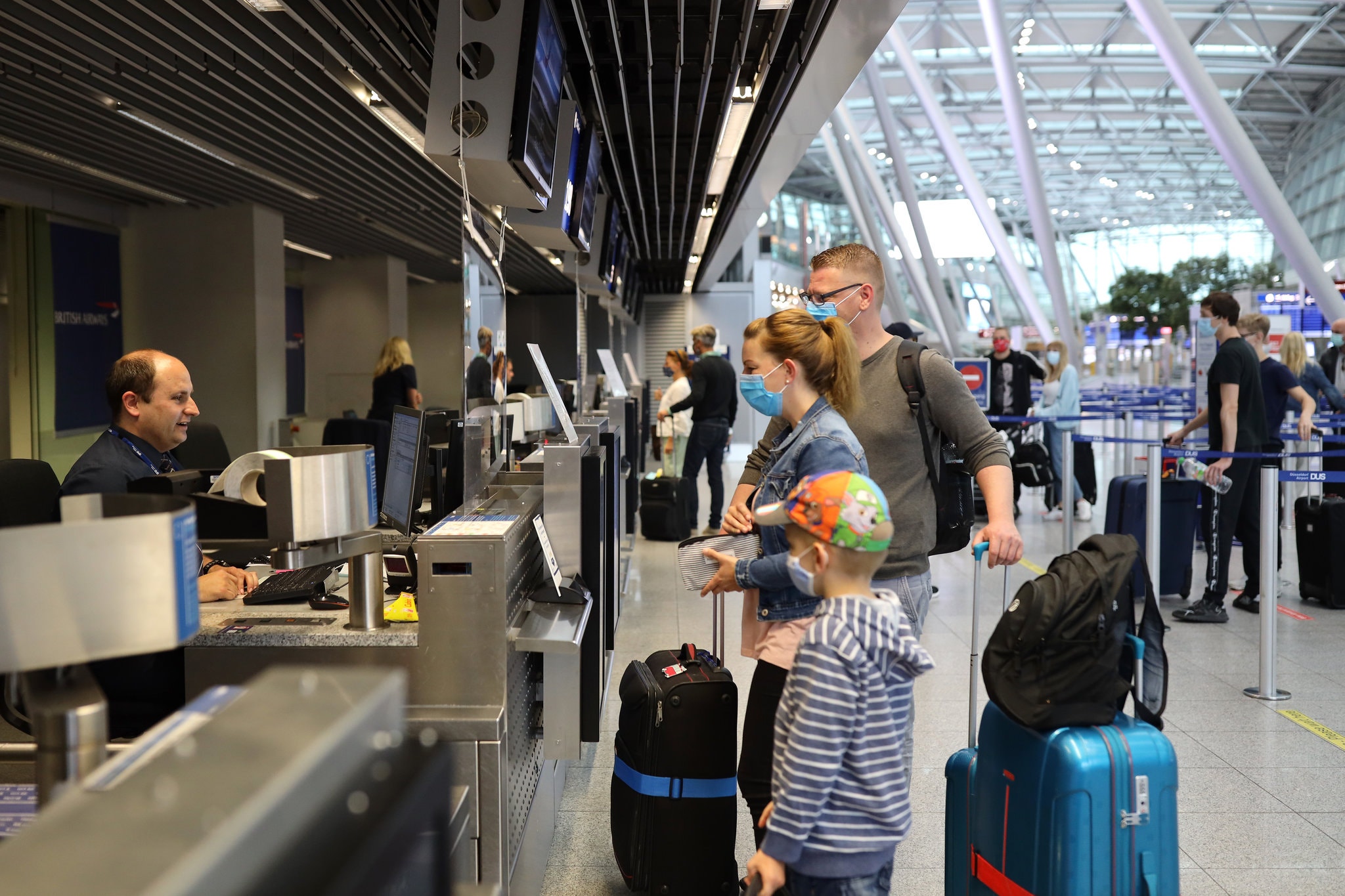
Tourists wait to check in at Dusseldorf Airport in Germany on Monday.Credit...Andreas Rentz/Getty Images
Europe’s internal borders, closed three months ago in a frenzy of panicked uncertainty, are opening again. In the delicate global stutter-step to restart stalled economies and save whole industries from financial ruin, the return of free and unfettered movement of people across the continent is a significant moment — one fraught with risk as new infections surge around the world.
France, Germany and Switzerland are among the nations that lifted restrictions on Monday for all arrivals from within the European Union and nations that fall under the border-free Schengen zone. They joined Spain, Italy, Belgium and other countries in trying to move to a new phase in the struggle to balance public health imperatives, economic realities and shifting public attitudes.
In order to facilitate navigating between different national rules, the European Commission launched “Re-open EU,” a site dedicated to information on travel to and within the European countries, including quarantine rules and information on tourist facilities.
For Europe, lifting internal border restrictions has important financial implications and deep symbolic resonance. Open borders — free from checkpoints and armed soldiers checking papers — have long been at the heart of the European project.
Analysis from CNN's Stephen Collinson
US President Donald Trump has no intention of accepting any new normal dictated by the coronavirus pandemic.
His big return-to-the-campaign trail rally set for Saturday night is dramatic proof of that. The event in Oklahoma, will be an extraordinary moment, even in a presidency that has often defied credulity.
In effect, it will be one of, if not the first, mass participation event indoors anywhere in the world in months. Trump's 20,000-strong crowd will be packed together, flouting social distancing, at a moment when major North American sports leagues are weeks away from playing games -- without spectators amid fears of creating "super-spreader" events.
The rally is only the most dramatic example of the President's refusal to temper his behavior any longer to reflect a pandemic that has buckled the rhythm of normal life. In order to push economic openings, he is continuing to spread disinformation about the disease and the state of US testing.
The cumulative effect is that it makes it seem like the worst public health crisis in 100 years has all but passed. By suppressing the White House appearances of leading governmental health officials and flouting his government's advice on wearing a mask, Trump is also downplaying the seriousness of a virus that is still killing thousands of Americans every week.
Trump on Monday suggested that the disease was already a faded threat in comments that defied science and logic.
From CNN's Swati Gupta in New Delhi
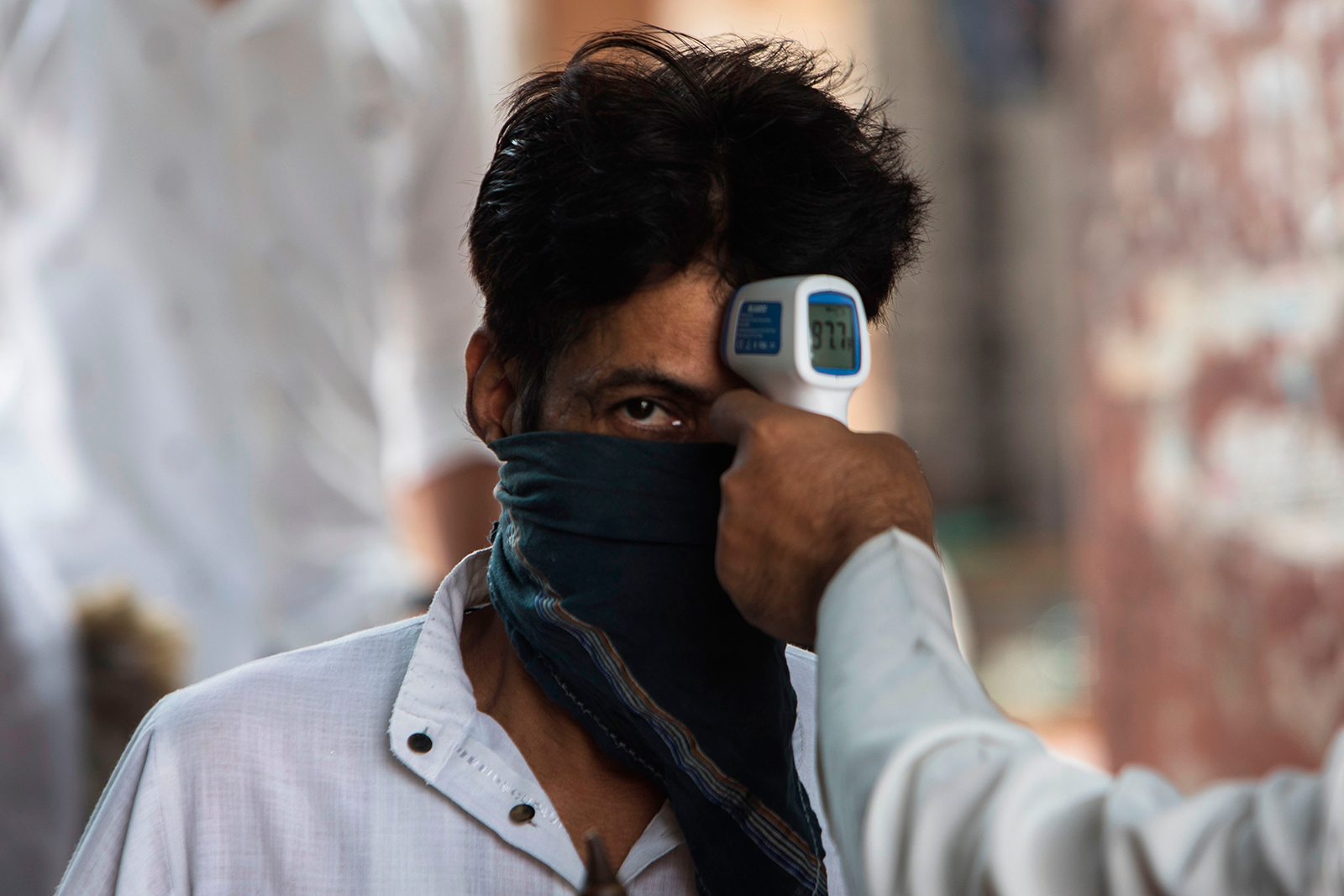
A Muslim man gets his body temperature checked as he arrives for Friday prayers at Fatehpuri Masjid in New Delhi on June 12. Xavier Galiana/AFP/Getty Images
India's central government and the local government of New Delhi have announced a series of measures following a steady increase in the number of confirmed Covid-19 cases in the capital.
The government has directed that testing capacity should be doubled in the next two days and tripled by the end of the week, according to a news release.
The New Delhi government will also be conducting house-to-house health surveys for contact tracing in containment zones in the city.
Private hospitals have been asked to ensure 60% of their beds are available to Covid-19 patients in anticipation of a possible influx of positive cases.
The measures come after 500 railway coaches, which were converted into isolation wards, will be moved into the city to increase the number of beds.
The Ministry of Railways said that 50 coaches equipped with the needed medical facilities have been installed at two local railway stations in the city.
The total number of confirmed cases in New Delhi stands at 42,829, including 1,400 deaths, according to the Ministry of Health and Family Welfare.
The city has reported the third-highest number of cases in the country.
From CNN's Swati Gupta in New Delhi
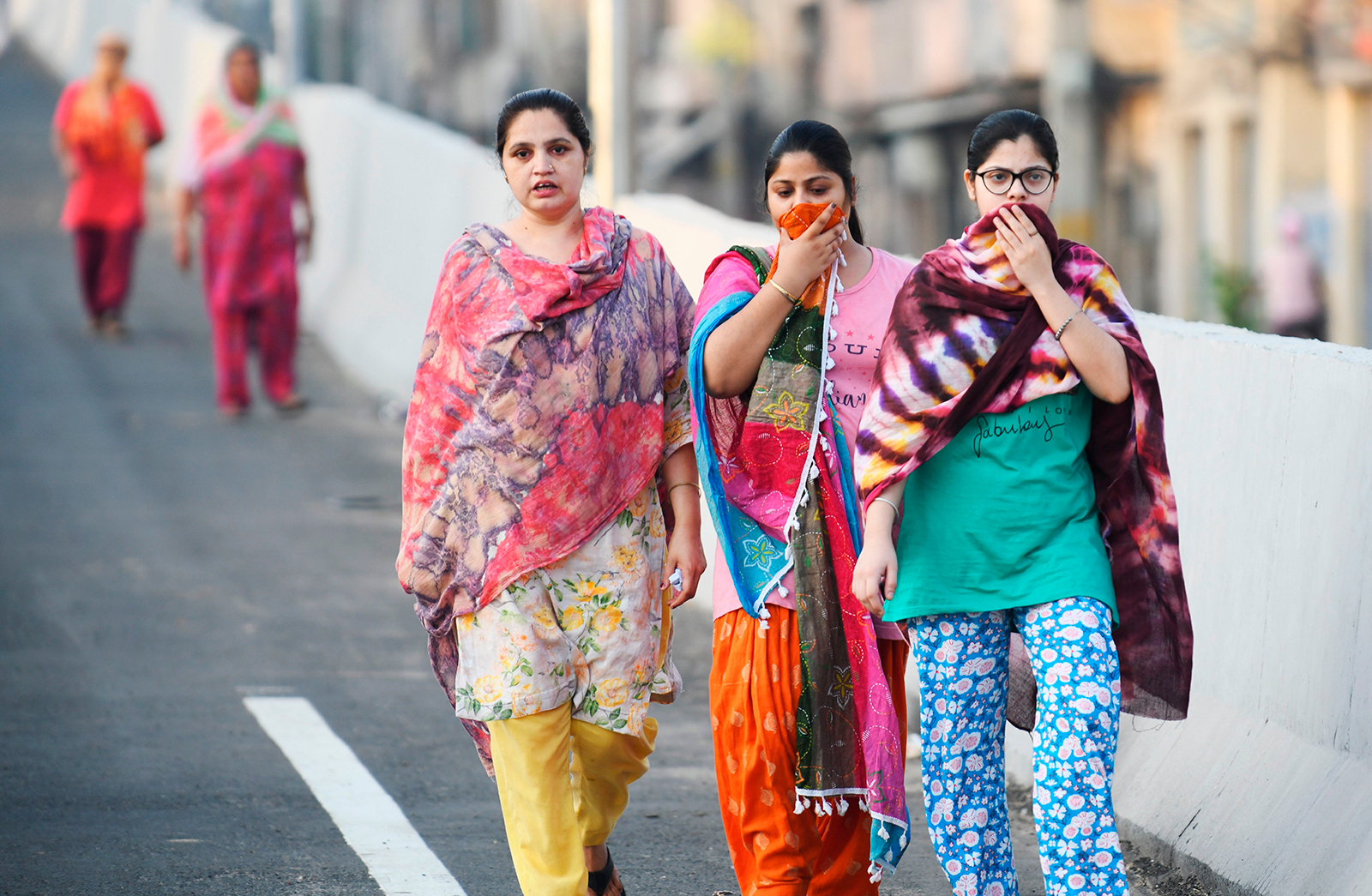
Women walk early in the morning along a road on the outskirts of Amritsar, India on June 16. Narinder Nanu/AFP/Getty Images
India recorded 10,667 new coronavirus cases and 380 deaths in the past 24 hours, according to the country's Ministry of Health and Family Welfare.
The number of confirmed cases in the country stands at 343,091, including 9,900 deaths.
India has conducted almost 6 million Covid-19 tests in total, with 154,935 taken in the past 24 hours, according to the Indian Council of Medical Research.
From CNN's Sophie Jeong

Director-General of Health Dr. Ashley Bloomfield speaks to media during a press conference at the Ministry of Health on June 16, in Wellington, New Zealand. Hagen Hopkins/Getty Images
New Zealand recorded two new cases of Covid-19 today, the country's Ministry of Health announced.
They are the first cases to be reported in the country in 24 days.
The two new infections are both women from the same family who arrived in New Zealand from the UK via Australia, according to the ministry's news release.
The women were allowed on compassionate grounds to leave their isolation at a hotel in Auckland and travel to Wellington via private vehicle to visit a relative who has since died, Director-General of Health Dr. Ashley Bloomfield said in a news briefing today.
From CNN's Julyanne Jucá, Rodrigo Pedroso and Rob Picheta
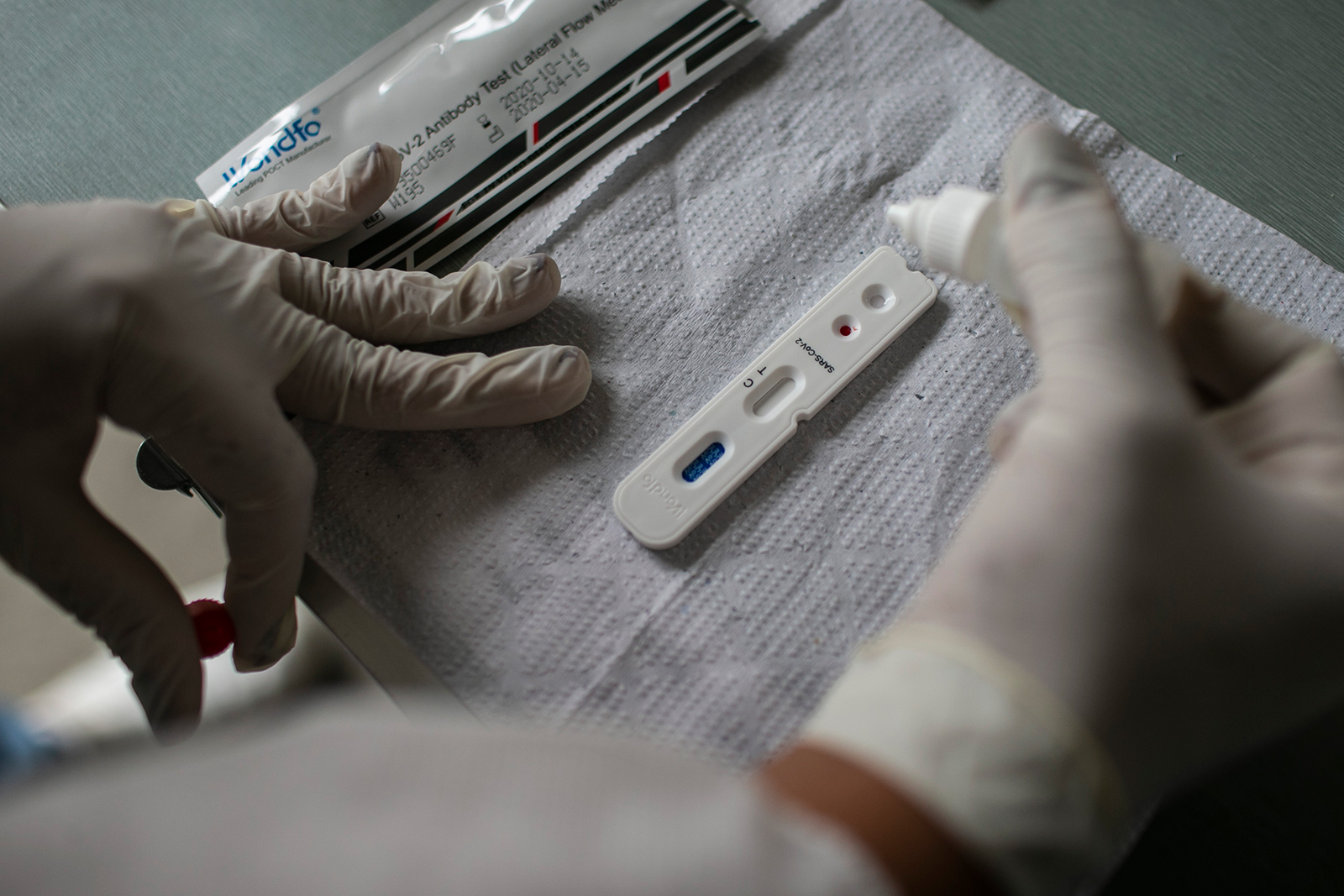
A coronavirus test kit at the Marques de Sapucai Sambadrome on June 15, in Rio de Janeiro, Brazil. Bruna Prado/Getty Images
Brazil's attorney-general has called for an investigation into several invasions of hospitals in the country, after its President called on Brazilians to inspect the conditions of medical wards treating Covid-19 patients.
Augusto Aras' request will be sent on Monday to several state prosecutor offices, including in São Paulo and Brasilia, where hospital invasions occurred on June 4 and June 9 respectively, according to a news release by the AG's office.
On June 4, several state deputies -- including some from Bolsonaro's party (PSL) -- also invaded a Covid-19 field hospital in São Paulo and took pictures of it, and patients without authorization, the city's mayor told CNN Brasil.
"This behavior endangers the physical integrity of the brave professionals who dedicate themselves to reversing a health crisis unprecedented in the country's history," the Attorney-General Augusto Aras said in the news release.
In a Facebook Live last Thursday, Bolsonaro called on citizens to enter hospitals to film the conditions themselves in order "to show if the beds are occupied or not."
Source:https://edition.cnn.com/world/live-news/coronavirus-pandemic-06-16-20-intl/index.html